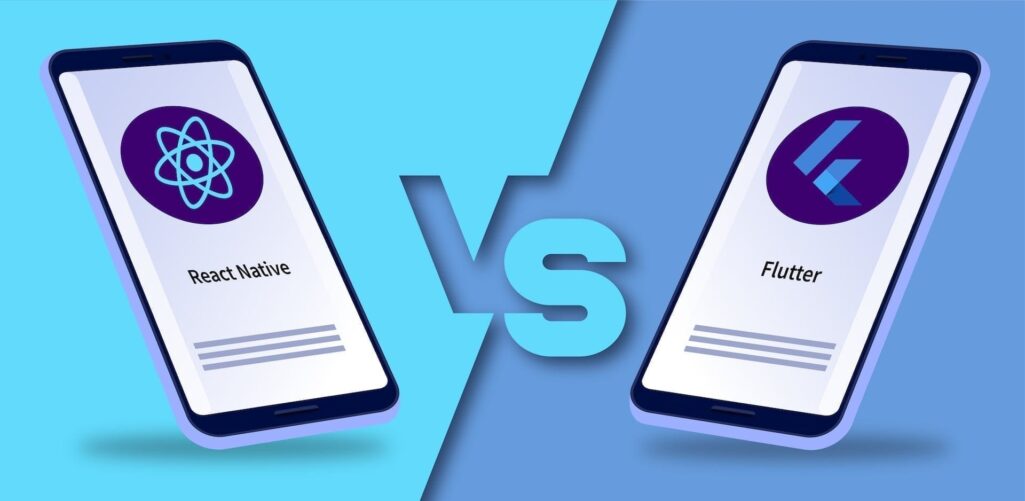Flutter vs React Native

Introduction:
In the ever-evolving landscape of mobile app development, cross-platform frameworks have gained significant traction. These frameworks enable developers to build mobile applications that can run seamlessly on multiple platforms, eliminating the need to write separate codebases for different operating systems. Among the most popular cross-platform frameworks are Flutter and React Native. In this blog post, we will delve into a comprehensive comparison between Flutter and React Native, analyzing their features, performance, community support, and more. By the end, you’ll have a clear understanding of which framework is the right fit for your next cross-platform app development project.
Introduction to Flutter:
Flutter, an open-source UI toolkit developed by Google, empowers developers to create natively compiled applications for mobile, web, and desktop from a single codebase. It employs the Dart programming language and offers an extensive collection of pre-designed widgets, facilitating the creation of visually appealing and responsive user interfaces. Flutter’s “hot reload” feature allows developers to instantly see changes in their app without losing its current state, resulting in a smooth and efficient development experience. Furthermore, Dart’s static typing aids in catching errors at compile-time, ensuring higher code quality.
Introduction to React Native:
React Native, maintained by Facebook, is a widely adopted JavaScript framework for building native-like mobile applications. Leveraging the power of React.js, it enables developers to write code in JavaScript while utilizing native components, resulting in a seamless user experience across platforms. React Native benefits from a large pool of developers and a vibrant ecosystem, making it an attractive choice, particularly for web developers. However, debugging and reloading can be slower compared to Flutter due to the underlying JavaScript bridge.
Development Experience:
Flutter’s development experience is lauded for its speed and efficiency. Its “hot reload” feature allows developers to make changes to their code and instantly see the results, facilitating rapid iteration and debugging. The framework provides a rich set of tools, extensive documentation, and a strong community support system, making it easy to get started and resolve any challenges along the way. Dart’s static typing helps catch errors early, reducing the likelihood of runtime issues.
React Native’s development experience is well-suited for JavaScript developers, leveraging the familiarity of the language and enabling code reuse from existing web projects. The framework benefits from the immense popularity of React.js, resulting in a large ecosystem, abundant resources, and an active community. However, debugging can be time-consuming, and the bridge between JavaScript and native code may introduce occasional performance bottlenecks.
Performance and User Interface:
Flutter shines in terms of performance and delivering a consistent user experience. Since Flutter apps are compiled into native code, they achieve near-native performance levels. Flutter’s UI rendering is smooth and consistent across different platforms, providing a native-like look and feel. Moreover, Flutter’s extensive collection of widgets and customizable UI elements allow developers to create stunning and highly interactive user interfaces.
React Native bridges the gap between native and JavaScript, offering good performance for most use cases. However, complex animations or computationally intensive tasks may require additional optimizations to match the performance of Flutter. While React Native provides access to a wide range of pre-built components, customizing the UI to achieve pixel-perfect designs can be challenging due to platform-specific differences.
Community and Ecosystem:
Both Flutter and React Native boast active and growing communities. Flutter’s community has experienced rapid expansion, with numerous packages, libraries, and tools being developed to enhance productivity and address specific needs. The Flutter community’s engagement, along with regular updates from Google, ensures continuous improvement and provides a solid foundation for developers to build upon.
React Native, backed by the popularity of React.js, enjoys a massive ecosystem and a large community of developers. This vibrant community contributes to the development of new libraries, utilities, and tools, making it easier for developers to find solutions to common challenges. However, React Native’s ecosystem is more mature and has a broader range of resources compared to Flutter.
Platform Support:
Flutter offers out-of-the-box support for both Android and iOS platforms, ensuring consistent UI and functionality across devices. Flutter’s ability to provide a uniform experience on various screen sizes and resolutions is a significant advantage, particularly for projects targeting multiple platforms.
React Native also supports both Android and iOS, but it may require additional configuration for certain platform-specific features. While React Native’s ability to leverage native components contributes to a more native-like experience, developers need to carefully handle platform differences to maintain consistency across devices.
Conclusion:
Choosing between Flutter and React Native depends on various factors, including development experience, performance requirements, and ecosystem support. Flutter offers highly performant applications with visually appealing UI, rapid development through hot reload, and a growing community. React Native, on the other hand, provides a familiar environment for JavaScript developers, a vast ecosystem, and a large community. Evaluating your project’s needs and considering the pros and cons of each framework will help you make an informed decision aligned with your development goals. Regardless of your choice, both Flutter and React Native empower developers to create cross-platform applications efficiently and effectively.